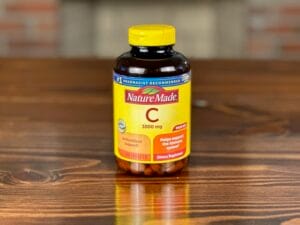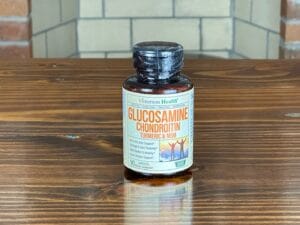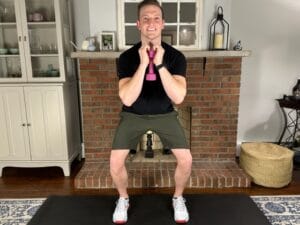Struggling With Knee Pain When Using Stairs? You're Not Alone and We Have the Best Exercises for You
Climbing stairs shouldn’t feel like a workout—or worse, a painful obstacle. But for many people recovering from knee injuries, surgeries, or general joint wear and tear, going up and down stairs can trigger discomfort, instability, or hesitation. This article is here to help. As a Doctor of Physical Therapy, I’ve created a simple, effective exercise plan that targets the key muscles responsible for stair strength and control.
These exercises are based on proven physical therapy principles I’ve used with hundreds of patients to rebuild quad strength, improve alignment, and regain confidence on stairs. You’ll find them organized by recovery phase—from activation and control, to functional movement—so you can progress safely at home.
Before we dive in, check out our related guides for additional knee support:
Let’s start with the foundation—early-phase exercises that activate the right muscles and begin restoring motion without irritating your knee joint.
Want a quick-reference PDF? Scroll down to the bottom of this post to grab your free printable plan!
Disclaimers and Disclosures: All information in this article is for informational and educational purposes only and should not be taken as individual medical advice. Additionally, this article contains affiliate links, meaning when you make a purchase, we make a small commission at no additional cost to you. For more information, see our full Disclaimers and Disclosures.
Phase 1: Weeks 0–3 – Activation and Motion Without Joint Load for Knee Pain Relief While Negotiating Stairs
During this early phase, the focus is on isolated muscle activation and joint mobility without weightbearing. These exercises help restore control and flexibility without compressive stress on the knee—ideal for anyone experiencing pain with stairs or instability.
Perform these exercises 1–2 times per day, only if pain stays mild and controlled.
This program was created by a Doctor of Physical Therapy and Orthopedic Clinical Specialist. As always, consult your healthcare provider before starting any new exercise regimen.
1. Bridges with Band
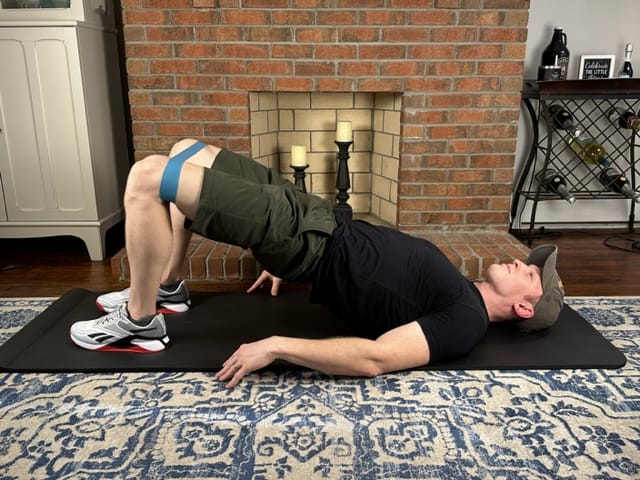
- Purpose: Activate glutes and core while unloading the knees.
- Benefits: Improves hip stability and helps correct knee alignment during stair use.
- How to Do It:
- Lie on your back with knees bent and band above knees.
- Squeeze glutes and lift hips off the floor, hold for 2 seconds at the top.
- Perform 15 repetitions and complete 2 sets.
- Helpful Link: Best Resistance Bands can be found in the link below.
2. Short Arc Quad
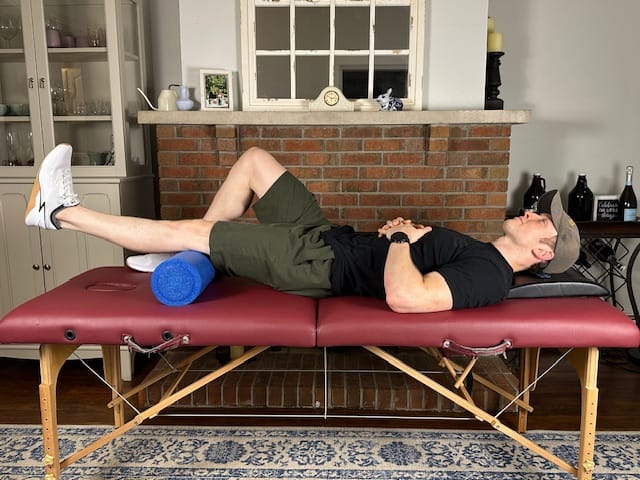
- Purpose: Strengthens quads through a small range of motion similar to that needed for stair climbing.
- Benefits: Supports strengthening without placing excessive stress on the knee.
- How to Do It:
- Rest your knee over a foam roll while lying on your back.
- Straighten the knee by lifting your heel off the surface, pause briefly at the top.
- Repeat 15 times, complete 2 sets. Add an ankle weight for an added challenge.
- Helpful Link: Best Ankle Weights and Foam Roll can be found in the links below.
3. Long Arc Quad
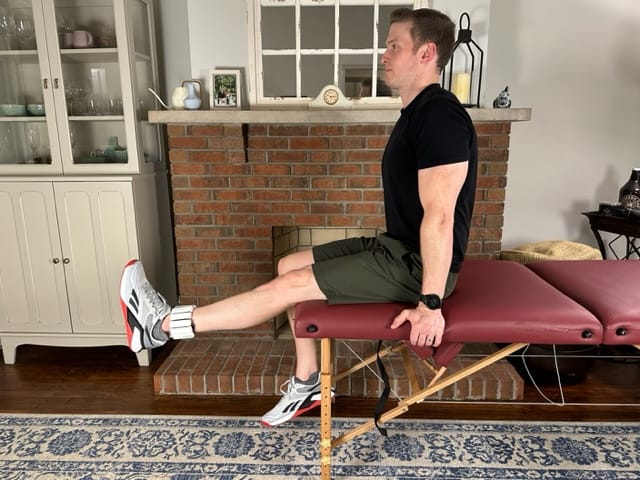
- Purpose: Strengthens the quads through a fuller range of motion.
- Benefits: Prepares the muscle for stairs without weightbearing.
- How to Do It:
- Sit upright with your thigh supported.
- Slowly extend your leg fully, hold briefly, then lower.
- Repeat 15 times, complete 2 sets. Add an ankle weight as strength improves.
- Helpful Link: Best Ankle Weights can be found in the link below.
4. Heel slides
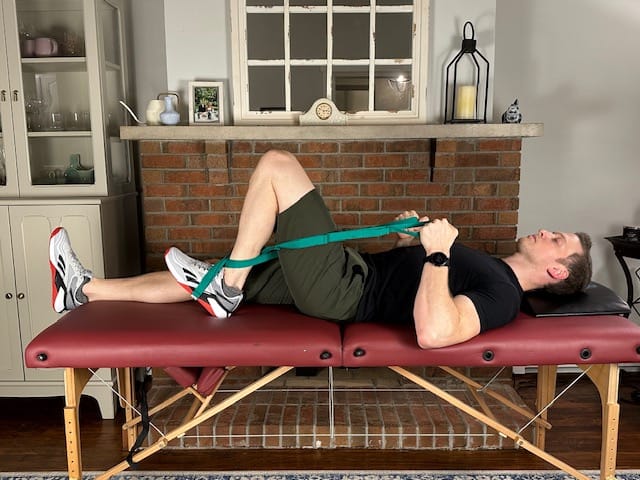
- Purpose: Gently stretches the quads and knee joint.
- Benefits: Promotes full motion and reduces stress on the knee.
- How to Do It:
- Loop a strap around your foot.
- Slide your heel slowly toward your buttocks, keeping your foot on the surface.
- Hold for 10 seconds and repeat 10 times.
- Helpful Link: Best Stretching Strap with loops can be found in the link below.
5. Straight Leg Raise
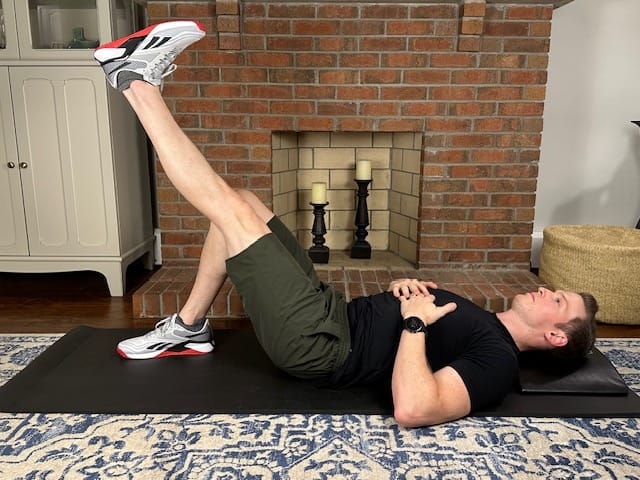
- Purpose: Strengthens the quad without moving the knee joint.
- Benefits: Builds foundational strength necessary for going up and down stairs.
- How to Do It:
- Lie on your back with one leg bent and the other straight.
- Tighten your thigh and lift the straight leg to the height of your bent knee, then lower slowly.
- Repeat 10 times, complete 2 sets.
- Helpful Link: Best Thick Yoga Mat for comfort can be found in the link below.
Bonus: Ice Pack and TENS for Knee Pain Relief from Stairs
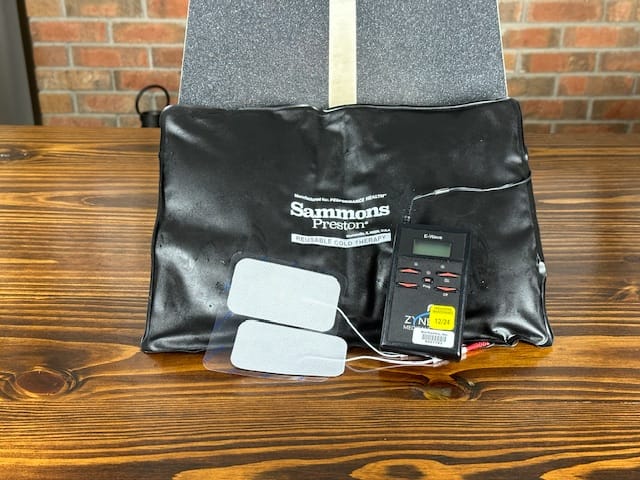
- Purpose: Reduce pain and inflammation due to stair climbing activities.
- Benefits: Enhances comfort and reduces swelling, especially after exercise.
- How to Use:
- Place TENS pads just over the painful area of the knee.
- Apply ice in a pillowcase for 10–15 minutes post-exercise.
- Helpful Link: Best TENS Unit and Ice Packs can be found in the links below
Phase 2: Weeks 3–6 – Weightbearing Control and Functional Strength Exercises for Stairs
Once pain is improving and your leg can tolerate more load, begin closed-chain and functional movements. These exercises simulate stair-related movements and target muscles needed for control and power going both up and down stairs.
Perform these exercises 4 times per week, and perform the exercises from phase 1 on the other days.
This program was created by a Doctor of Physical Therapy and Orthopedic Clinical Specialist. As always, consult your healthcare provider before starting any new exercise regimen.
1. Prone Quad Stretch
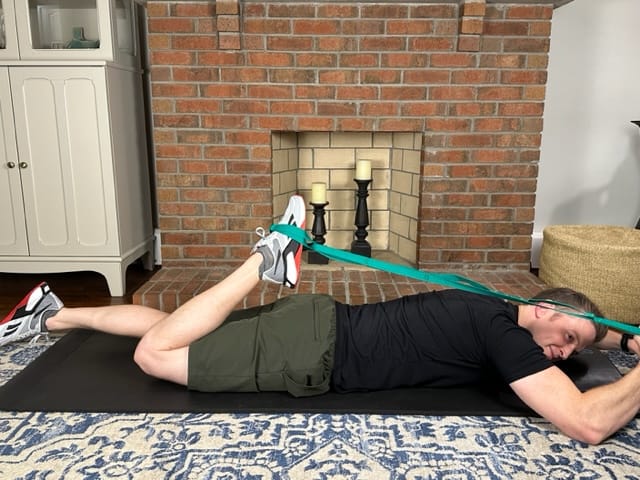
- Purpose: Lengthens the quad muscle and reduces tension on the knee.
- Benefits: Reduces stress on the knee and improve mobility for stairs.
- How to Do It:
- Lie on your stomach and loop a strap around your ankle.
- Gently pull until you feel a stretch in the front of your thigh.
- Hold for 10 seconds, repeat 10 times.
- Helpful Link: Best Stretching Strap with loops can be found in the link below.
2. Sidesteps With Band
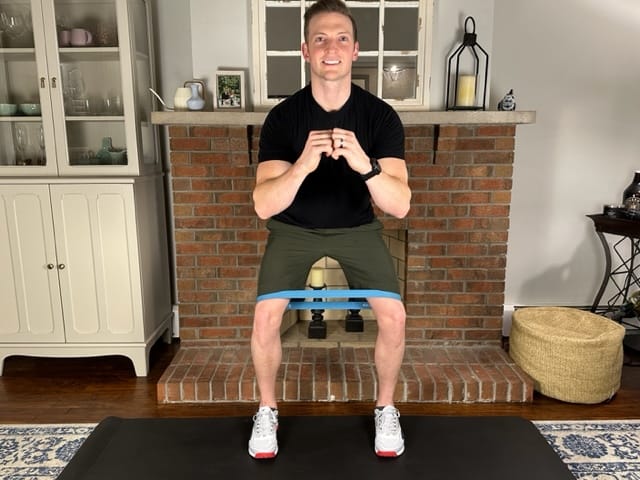
- Purpose: Strengthen glutes and hip stabilizers for knee alignment.
- Benefits: Improves knee control and reduces dynamic valgus while doing stairs.
- How to Do It:
- Place a resistance band just above your knees and lower into a mini squat.
- Step sideways slowly, keeping tension in the band.
- Perform 12-15 steps in each direction, rest, and repeat 3 times.
- Helpful Link: Best loop Resistance Bands can be found in the link below.
3. Forward Step-Ups
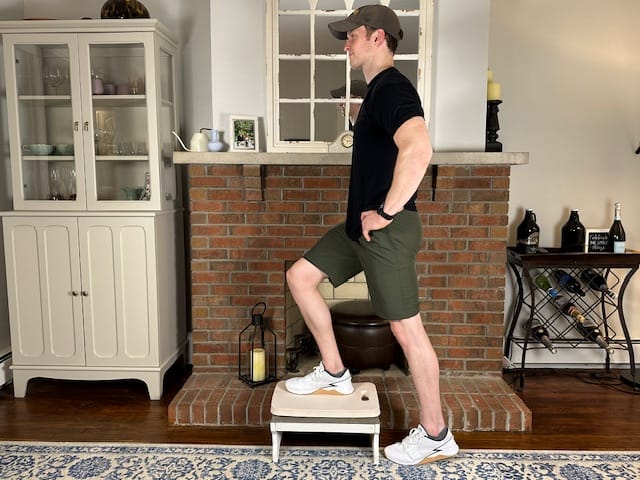
- Purpose: Strengthens quad and glutes in a functional movement.
- Benefits: Builds strength for stairs and daily activities.
- How to Do It:
- Stand in front of a low step with a counter nearby for balance.
- Step up with your injured leg, then lower with control.
- Perform 10 reps, complete 2 sets. Increase height as strength and pain progresses.
- Helpful Link: Best Adjustable Stepper can be found in the link below.
4. Lateral Step-Overs
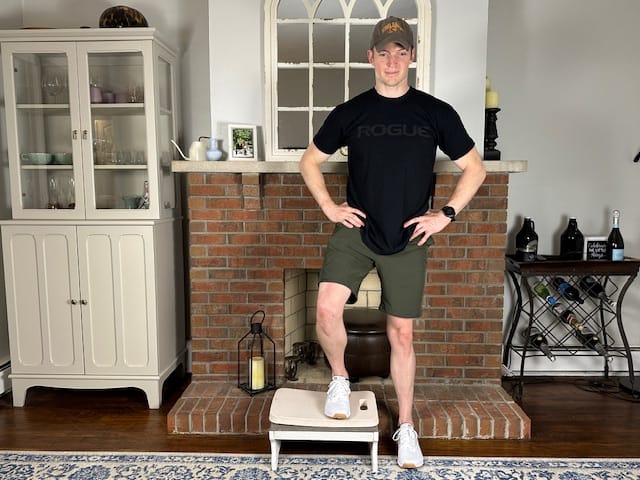
- Purpose: Enhances coordination and eccentric quadriceps control.
- Benefits: Improves stability and prepares for eccentric control with descending stairs.
- How to Do It:
- Stand beside the low step and step laterally up with your outer leg.
- Bring the other leg up, then step down to the other side.
- Return to start in the same fashion, complete 10 reps and perform 2 sets.
- Helpful Link: Best Adjustable Stepper can be found in the link below.
5. Goblet Squats
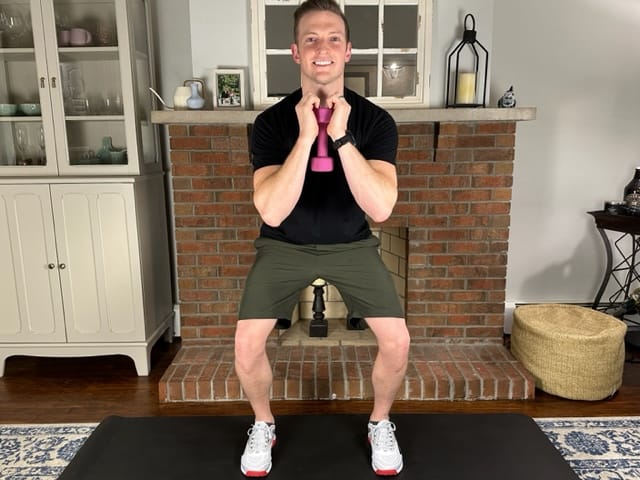
- Purpose: Builds compound strength in quads, glutes, and core in a functional movement pattern.
- Benefits: Improves squat mechanics, knee control, and lower body power for both stair ascent and descent.
- How to Do It:
- Hold a dumbbell close to your chest with elbows down.
- Squat down slowly, keeping your chest tall and knees aligned.
- Press through your heels to return to standing 10 times, complete 2 sets.
- Helpful Link: Best Dumbbell Weights can be found in the link below.
Looking for a simple way to stay consistent?
👉 Download the free full Knee Exercise Program for Pain Free Stairs + Exercise Tracker (PDF) to follow and log your daily progress.
Best Exercises for Knee Pain Relief with Stairs: Final Thoughts
Going up and down stairs shouldn’t be painful—but for many people recovering from injury, surgery, or joint irritation, stair navigation becomes a daily challenge. The good news? A focused rehab program that strengthens your legs, improves control, and rebuilds confidence can help you return to stairs without hesitation.
This PT-designed home exercise plan breaks down your recovery into two progressive phases. In Phase 1, we emphasize quad activation and mobility without loading the joint. In Phase 2, we introduce weightbearing movements to help you practice stair mechanics safely and effectively. All exercises can be done at home with minimal equipment.
Stay consistent, prioritize control over speed, and avoid sharp pain. With time and proper progression, you’ll rebuild strength, reduce instability, and move through stairs with more comfort and confidence.
Why Trust Physical Therapy Simplified for Knee Pain with Stairs Exercises?
At Physical Therapy Simplified, our mission is to provide an accessible, trustworthy source of physical therapy guidance that anyone can understand, follow, and benefit from. We want you to feel confident that you’re getting evidence-based advice and the best pain-relieving knee exercises for stairs—all designed to reduce pain and restore your highest functional potential.
This article was written by Andrew Harkins, PT, DPT, OCS, a licensed physical therapist with over twelve years of clinical experience. He is certified by the American Board of Physical Therapy Specialties as an Orthopedic Clinical Specialist and has successfully helped thousands of patients improve stair mobility, overcome knee pain, and restore functional strength through structured home rehab plans.
Andrew has also served as a teaching assistant at the University of Pittsburgh’s Doctor of Physical Therapy Program, where he contributed to education on knee injuries, joint preservation, and lower extremity biomechanics. His evidence-based, real-world approach ensures you’re getting trusted information that’s research-backed and has helped real people get better, faster.
